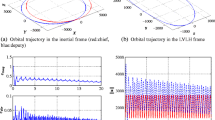Abstract
Statistical orbit determination is an important part of tracking satellites and predicting their future location. This is accomplished by processing the raw observation data from ground stations tracking satellites in orbit and estimating the location of these satellites. Kalman filter theory is a popular statistical process but it is not commonly used for satellite orbit determination because it exhibits poor stability characteristics in this application. In particular, an Extended Kalman Filter (EKF) is needed for this application because the orbit determination problem is a nonlinear one. The EKF does not lend itself well to the traditional eigenvalue stability analysis, which is applicable for linear, time-invariant systems. If the stability characteristics of the EKF used for the orbit determination problem were better understood, it could become useful for these applications. A stability analysis concept which has received much attention is Lyapunov’s stability theory. The focus of this paper is to apply the second method of Lyapunov (or the direct method) to evaluate the stability characteristics of an EKF estimating a satellite’s orbit using simulated radar data from ground tracking stations at Mahe Island and Thule. Specifically, a Lyapunov function is used to analyze the stability characteristics of that EKF while selecting the weighting matrices of the filter for the satellite orbit determination problem.
Similar content being viewed by others
References
LARSON, W., and WERTZ, J. Space Mission Analysis and Design, 1st ed., Kluwer Academic Publishers, Dordrecht, the Netherlands, 1992, pp. 579–599.
VALLADO, D. A. Fundamentals of Astrodynamics and Applications, McGraw-Hill, New York, 1997, pp. 649–738.
BELLMAN, R., and COOKE, K. Differential-Difference Equations, Academic Press, New York, 1963, pp. 111–187.
MOORE, J., and ANDERSON, B. “Coping with Singular Transition Matrices in Estimation and Control Stability Theory,” International Journal Control, 1980, pp. 571–586.
SONG, T., and SPEYER, J. “A Stochastic Analysis of a Modified Gain Extended Kalman Filter with Applications to Estimation and Bearing Only Measurement,” IEEE Transactions on Automatic Control, Vol. AC-30, No. 10, 1985, pp. 940–949.
SONG, T., and SPEYER, J. “The Modified Gain Extended Kalman Filter and Parameter Identification in Linear Systems,” Automatica, Vol. 22, No. 1, 1986, pp. 59–75.
GELB, A., KASPER, J., NASH, R., PRICE, C., and SUTHERLAND, A. Applied Optimal Estimation, The Analytic Sciences Coorporation, Cambridge, Massachusetts, 1974.
BATE, R., MUELLER, D., and WHITE, J. Fundamentals of Astrodynamics, Dover Publications, New York, 1971, pp. 385–419.
SELLERS, J. Understanding Space, An Introduction to Astronautics, McGraw-Hill, New York, 1994, pp. 246–267.
BERTRAM, J. E., and SARACHIK, P. E. “Stability of Circuits with Randomly Time-Varying Parameters,” IEEE Transactions on Circuit Theory, May 1959, pp. 260–270.
MAYBECK, P. S. Stochastic Models, Estimation, and Control, Vol 3, Academic Press, New York, 1982, pp. 45–121.
ANDERSON, B., and MOORE, J. Optimal Filtering, Prentice-Hall, Englewood Cliffs, 1979, pp. 97–131.
D’AZZO, R. S., and HOUPIS, C. H. Linear Control System Analysis and Design, McGraw Hill, New York, 1975, pp. 509–519.
LUENBERGER, D. “An Introduction to Observers,” IEEE Transactions on Automatic Control, Vol. AC-16, No. 6, 1971, pp. 596–602.
ROUCHE, N., HABETS, P., and LALOY, M. “Stability Theory by Liapunov’s Direct Method,” Springer-Verlag, Paris, 1977, pp. 1–89.
MAYBECK, P. S. Stochastic Models, Estimation, and Control, Vol. 1, Academic Press, New York, 1982, pp. 133–195.
SAFONOV, M., and ATHANS, M. “Robustness and Computational Aspects of Nonlinear Stochastic Estimators and Regulators,” IEEE Transactions Automatic Control, Vol. AC-23, No. 4, 1978, pp. 717–725.
VERGEZ, P. “Closed-Loop System Analysis Using Lyapunov Stability Theory,” Ph.D. Dissertation, University of Texas at Austin, Austin, Texas, May 1987.
Author information
Authors and Affiliations
Rights and permissions
About this article
Cite this article
Vergez, P.L. Lyapunov Stability Analysis of an Orbit Determination Problem. J of Astronaut Sci 45, 233–245 (1997). https://doi.org/10.1007/BF03546378
Published:
Issue Date:
DOI: https://doi.org/10.1007/BF03546378




